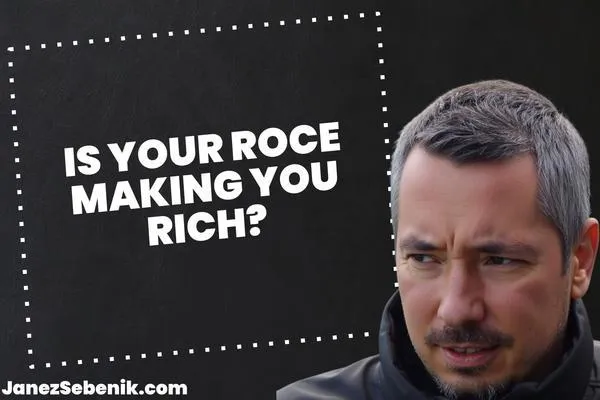
What Is Considered a Good ROCE?
Ever wondered what makes a company's financial performance truly impressive? Let's talk about Return on Capital Employed (ROCE). It's a key metric that shows how well a business uses its money to make more money.
A good ROCE is typically above 10-15%, but it varies by industry. Some top-performing companies can hit 20% or higher. The higher the ROCE, the better the company is at turning investments into profits.
ROCE helps you see which companies are the real deal. It's like a financial report card that shows how efficiently a business uses its resources.
When you're picking stocks or analyzing companies, ROCE can be your secret weapon.
Key Takeaways
ROCE above 10-15% is generally considered good, but it depends on the industry
ROCE helps investors gauge a company's efficiency in using capital to generate profits
Comparing ROCE across similar companies can reveal which ones are top performers in their field
Decoding ROCE
Let's break down ROCE - Return on Capital Employed. It's a fancy way of saying "How well is this company using its money?"
ROCE is a financial ratio that shows if a business is making good use of its cash. Think of it like a report card for grown-up companies.
Here's the deal: You take the company's profits before taxes and interest, then divide it by the total money they're using. Simple, right?
A higher ROCE is better. It means the company is squeezing more profit out of every dollar they use. Like getting an A+ on that report card.
But what's a "good" ROCE? It depends on the industry. Some businesses need more money to run, so their ROCE might be lower.
Here's a pro tip: Compare a company's ROCE to others in the same field. That'll give you a real sense of who's top of the class.
Remember, ROCE is just one tool in your investing toolbox. Don't make decisions based on this alone. But it's a great starting point to see if a company is using its capital wisely.
Why ROCE Matters
ROCE is a big deal for figuring out how well a company uses its money. It shows if a business is making smart choices with its cash.
The Investor's Perspective
You're an investor. You want to know if a company is worth your money. ROCE helps you see that. It's like a report card for how well a business uses its capital.
High ROCE? That's good. It means the company is making more profit from what it spends. Low ROCE? Not so great. The business might be wasting money.
You can compare ROCE between different companies. It's a quick way to spot the winners. But remember, it's not the only thing to look at.
Evaluating Company Health
ROCE is like a health check for a business. It shows if a company is in good shape or needs to shape up.
A strong ROCE means the company is using its resources well. It's making smart investments. That's a sign of good management.
Weak ROCE? Red flag. The company might be struggling. Maybe it's investing in the wrong things. Or it's not efficient enough.
You can track ROCE over time. Is it going up? The company's getting better at using its money. Going down? There might be trouble ahead.
ROCE helps you spot trends. It's a tool to predict a company's future. Use it to make smarter investment choices.
Breaking Down the Math
Let's crunch some numbers and see how ROCE works. You'll get the lowdown on calculating this key metric and what goes into it.
Calculating ROCE
Ready to flex those math muscles? Here's the ROCE formula: ROCE = EBIT / Capital Employed.
EBIT stands for Earnings Before Interest and Taxes. It's the money your company makes before paying the taxman and lenders.
Capital Employed is what you're using to make that cash. It's Total Assets minus Current Liabilities.
So, you're basically seeing how much profit you squeeze out of every dollar you put to work. Cool, right?
Components of ROCE
Let's break it down further. EBIT is your company's operating profit. It shows how good you are at your core business.
Capital Employed is trickier. It includes everything you use long-term to make money. Think buildings, machines, and investments.
Total Assets are all the goodies your company owns. Current Liabilities are what you owe soon, like bills and short-term loans.
By subtracting Current Liabilities from Total Assets, you get a clearer picture of your long-term capital. It's like seeing how much horsepower your business really has under the hood.
Remember, a higher ROCE means you're squeezing more profit out of your capital. It's like getting more miles per gallon in your car. Efficiency is king!
ROCE in Action
ROCE shows how well companies use their money. Let's look at how different businesses stack up and some real-world examples.
Sector Performance Comparison
You gotta compare apples to apples. ROCE varies by industry. Telecom firms? They're capital-heavy. Oil and gas? Same deal.
In telecom, a 10% ROCE might be solid. But in tech? That's weak sauce.
Want to know if a company's crushing it? Look at its ROCE next to industry peers.
Here's a quick breakdown:
Tech: 20%+ is fire
Retail: 15%+ is strong
Manufacturing: 12%+ is good
Remember, higher isn't always better. Super high ROCE might mean a company's not investing enough in growth.
Case Studies: Successes & Failures
Let's get real with some examples.
Success story: Apple. Their ROCE? It's been over 20% for years. That's insane efficiency. They turn capital into cash like magic.
Failure alert: Uber. In 2019, their ROCE was negative. Ouch. They were burning cash faster than a dumpster fire.
What about oil giants? ExxonMobil's ROCE dropped from 16% to 6% in five years. Not great, but still positive.
Analysts love ROCE for spotting trends. Rising ROCE? Could mean growing market share. Falling ROCE? Might be time to dig deeper into that financial data.
Your takeaway? ROCE is a powerful tool. Use it to spot winners and avoid losers in your portfolio.
Interpreting ROCE
ROCE tells you how well a company uses its money to make more money. It's like checking how good a business is at turning cash into profit.
What Defines a 'Good' ROCE?
A good ROCE is like a home run in baseball. You want it to be high, but what's high depends on the game you're playing.
In business, a ROCE above 10-15% is usually considered good. But don't stop there. You need to compare it to other companies in the same industry.
Think of it like this: If you're selling ice cream, you can't compare yourself to a car manufacturer. Different businesses have different standards.
A higher ROCE means the company is doing a better job at making money from what it has. It's like getting more bang for your buck.
ROCE Benchmarks
Benchmarking ROCE is like comparing your exam scores to your classmates. It helps you see where you stand.
Look at the top performers in the industry. Their ROCE can give you a target to aim for. But remember, the highest isn't always the best.
You should also compare ROCE to other metrics like return on equity (ROE). It's like checking your math homework with different methods.
Don't forget about profit margins. A high ROCE with low margins might mean the company is cutting corners. You want both to be healthy.
Remember, ROCE is just one piece of the puzzle. Use it with other tools to get the full picture of a company's performance.
Beyond the Numbers
ROCE is useful, but it's not the whole story. Let's look at what else matters and where ROCE falls short.
Qualitative Factors
You can't just rely on numbers. A company's future depends on more than math.
Think about the people running the show. Are they rockstars or duds? A great leader can turn a struggling business around.
What about the company's reputation? If customers love them, that's gold. Bad press? Not so much.
Don't forget about innovation. Is the company always coming up with new ideas? That could mean big bucks down the road.
And the market? Is it growing or shrinking? You want to bet on a horse in a race that's actually happening.
Limitations of ROCE Analysis
ROCE isn't perfect. It's got some blind spots you need to know about.
First up, ROCE doesn't account for intangible assets. Things like patents or brand value? They don't show up.
Inventory can mess with ROCE too. A company might look great on paper just because they're sitting on a ton of stock.
ROCE also ignores debt. A company could be drowning in loans, but ROCE won't tell you that.
External factors? ROCE doesn't care. Economic downturns, new regulations - these can tank a business, but ROCE stays blind.
Lastly, ROCE is a snapshot. It doesn't show trends over time. You might miss a company on the rise or one that's about to crash.
Maximizing ROCE
Want to boost your ROCE? It's all about smart money moves and running a tight ship. Let's dive into how you can squeeze more profit out of every dollar you've got invested.
Effective Capital Allocation
First up, you've gotta be smart with your cash. Don't just throw money at every shiny object. Focus on investments that'll give you the biggest bang for your buck.
Look for projects with high returns and low risk. It's like picking the winning horse at the races, but way less gambling.
Got some dead weight? Cut it loose. Sell off assets that aren't pulling their weight. Use that cash for something that'll actually make you money.
And hey, don't forget about your working capital. Keep it lean and mean. You want your money working for you, not sitting around collecting dust.
Operational Efficiency Strategies
Now, let's talk about running a tight ship. You want to squeeze every drop of profit out of your operations.
Start by streamlining your processes. Cut out the fluff. If it's not adding value, it's gotta go.
Automate where you can. Robots don't take coffee breaks or call in sick. They just work, work, work.
Train your team to be lean, mean, profit-making machines. The better they are at their jobs, the more money you'll make.
And always be on the lookout for waste. It's like finding loose change in your couch cushions, but on a much bigger scale.
Remember, efficiency is key. The leaner you run, the higher your ROCE will climb. It's not rocket science, it's just smart business.
Long-Term Strategy and Growth
You want your business to grow, right? Well, ROCE is your secret weapon. It helps you spot the best investment opportunities for long-term success.
Think about it. A high ROCE means you're using your capital wisely. You're getting more bang for your buck. This extra cash can fuel your growth plans.
But here's the kicker: ROCE is especially crucial in capital-intensive industries. These are the big boys - manufacturing, utilities, telecoms. If you're in one of these, you need to watch your ROCE like a hawk.
Why? Because these industries need loads of cash to keep running. A good ROCE shows you're not just burning money. You're building something that lasts.
ROCE's Role in Sustainable Success
ROCE isn't just about making money today. It's about setting you up for tomorrow's wins. A consistently high ROCE gives you a competitive advantage.
How? It means you're efficient. You're squeezing more profit out of every dollar you invest. This efficiency can help you weather tough times and come out on top.
But don't get too caught up in the numbers. ROCE should guide your decisions, not dictate them. Sometimes, you might need to sacrifice short-term ROCE for long-term gains.
The key is balance. Use ROCE to spot areas where you can improve. Then, make smart moves to boost your efficiency. This way, you're not just surviving - you're thriving for the long haul.
